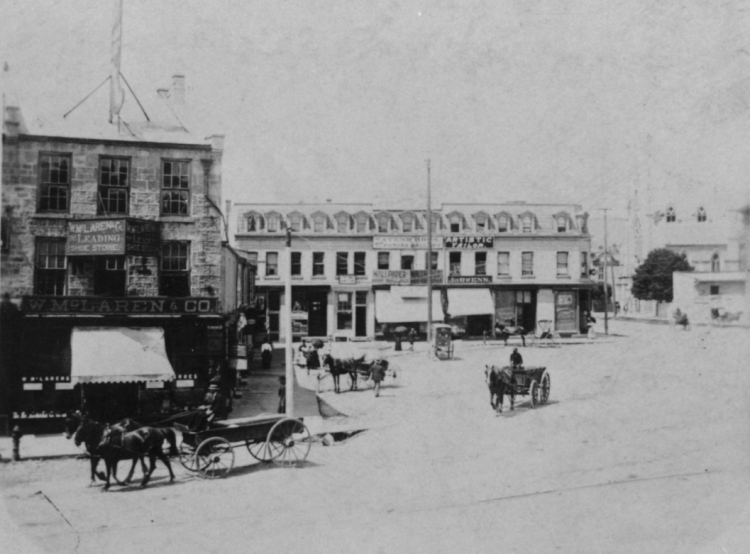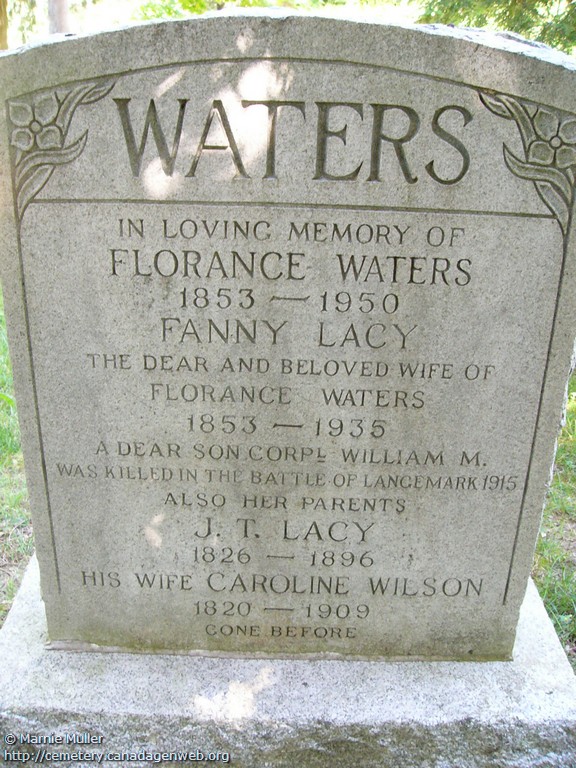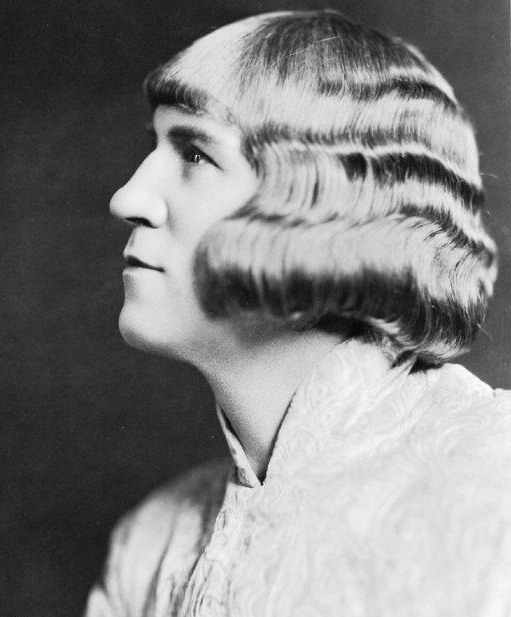(Courtesy of the John W. Keleher collection.)
The caption on the front reads, "Winter scene in Guelph City. Delhi Street, March 23rd 1912." On the back is the message:
May 19th, 1912 // My Dear Molly // Don’t be suspicious if Marg. Wolfe & I am up some Sunday morning when the days are a little warmer. This is a snap I took this winter but is not very clear as the cards & plates are old. It is the sidewalk leading to the Homewood Sanitarium. With love from EllaThe postcard was addressed to Miss Gertie Maitland of nearby Ponsonby, Ontario.
It is always welcome when such real-photo cards include details of the views they depict. It seems likely that one of the women in the picture is Ella, though the identity of the trio remains uncertain. Of course, the remarkable feature of the scene are the heaps of snow on either side of them. Surely, the winter of 1912 is what is now called an "old-time winter". Of course, some strategic shoveling may have been used to exaggerate the extent of the recent snowfall for photographic purposes.
Looking back on this scene from over 100 years later invites us to recall the winter season of 1911–12, starting with the Xmas holiday.
The Christmas season of 1911 began with an athletic spectacle in the form of a ten-mile footrace between Tom Longboat and Fred Meadows (Mercury, 1 December 1911). Longboat was an Onandaga (Haudenosaunee name Cogwagee) distance runner from the Six Nations Reserve and already had an international reputation after winning the Boston Marathon in 1907 and turning professional.
(From left to right: Meadows, Wood, Queal, and Longboat, ca. 1910–1915; Bain News Service/Wikimedia Commons)
The race took place at the Victoria Rink (since demolished), situated behind Knox Presbyterian Church. Since there were 12 laps to the mile in the Rink, the race would go for 120 laps. Over 1000 people crowded into the rink to see the event, which Longboat led all the way, winning in 51.5 minutes, a lap and a half ahead of Meadows.
Longboat also served in the Great War as a dispatch runner and survived the conflict in spite of being wounded twice. June 4, his birthday, is now known in Ontario as Tom Longboat Day in his honour.
Guelph enjoyed a visit from another fine performer on the same day in the person of Miss Mabel Beddoe, a contralto singer from Toronto who was at the outset of a distinguished career spanning North America. The Norfolk Street Methodist Church (now Lakeside Church downtown) put on a choral performance with Miss Beddoe as feature soloist. The Mercury (1 December) expressed the crowd's delight with her singing:
Miss Mabel Beddoe, of Toronto, was the soloist of the evening and her numbers were a veritable treat to the music lovers of the city, who were present. She possesses a mezzo contralto voice of richness and purity, of volume and elasticity, which was delightful to listen to. Her enunciation was perfect, her control thorough, and she possesses dramatic qualities and expression, such as few of the many vocalists who come to Guelph possess. Kipling's beautiful "Recessional" to the music of Reginald DeKoven was especially fruitful in dramatic force, as was Bruno Huhn's "Invictus." Her second number, "I am far frae my hame," the delightful old Scotch air, was a favorite, and brought tears to the eyes of many of the land of the heather. Her other numbers, all of which were heartily appreciated, were the arias, "God shall wipe away all tears," Sullivan; "He shall feed his flock," from "The Messiah," and E.L. Ashford's "My task."
(Mabel Beddoe, Courtesy of The Globe, 11 September 1929.)
Perhaps an idea of the performance can be gained from Robert Merrill's performance of Invictus in 1947.
Besides these special visitors, Guelphites awaited the arrival of old man winter, whose snow and ice afforded pleasant, seasonal recreation. There was both bad news and good news (Mercury, 4 December). The bad news was that Mr. Foster, Manager of the Street Railway (streetcar), had decided against providing a toboggan slide in the park behind the car barn on Waterloo Avenue. The children, and some adults, of the Royal City could take consolation in the use of their usual toboggan venues, which often included the precipitous hills on Cork Street and Eramosa Road.
The good news was that the skating rink behind the car barns was to open in a few days. So, anyone looking to get an early start on skating could simply ride the streetcar down Waterloo Avenue and skate on the pond at the current location of Howitt Park.
Of course, the most anticipated visitor of the season was Santa Claus. To judge from the pages of the Mercury, no one looked forward to this night with more gusto than the storekeepers of the Royal City. Many ads urge Guelph's citizens to shop early and often so as not to disappoint the many good girls and boys of the town. Pictures of Santa generously imparting gifts are included as a model of the appropriate behaviour.
The ad above, from 9 December, announces the opening of Toyland at D.E. Macdonald & Bros. emporium, on the southeast corner of Wyndham and Macdonnell streets.
With the fireplace in the background, this first ad refers to the tradition that Santa flew from house to house in a magic sleigh and entered each dwelling down its chimney. Other ads testify that Santa was progressive and could change with the times.
This ad on 15 December, from the Kandy Kitchen on Wyndham Street, shows that the jolly old elf grasped the advantages and perhaps the pleasures of the automobile, anticipating by many years the modern reliance on delivery vehicles to bring Christmas home.
Another ad on 18 December from D.E. Macdonald & Bros. shows Saint Nick riding the cutting edge of contemporary technology, delivering presents from an airplane resembling a Wright Flyer.
This advertisement eerily foreshadows the use of drones to bombard houses with Xmas presents greatly anticipated by Guelphites today.
Perhaps because it was then old hat, Santa was not depicted making deliveries by streetcar. Yet, a significant development in Guelph was the expansion of the streetcar network into St. Patrick's Ward (AKA "The Ward") in 1911. On 14 December, shortly before 11am, the first streetcar made its way from St. George's Square into the Ward (Mercury, 14 December). Inside it were the usual dignitaries, including Manager Foster and Commissioners Lyon, Ryan, and Drew, and reporters from the Mercury, Herald, Toronto Globe, and the Mail and Empire.
The procession made good time and was observed by many of the Ward's residents from their sidewalks and doorways. The route went down Neeve street, over the bridge, along Ontario street and then York road. The route was originally conceived by J.W. Lyon for freight only, to help service the factories that were springing up in the area. However, passenger service was added in 1912, which proved to be popular with Ward residents who commuted to work in other parts of town.
The highlight of the maiden trip of the new line was when James Gow, of Ontario street, stopped the car and presented each passenger with a cigar.
(Streetcar on York Road, 1920s. Courtesy of Guelph Civic Museums 2014.30.1.)
Xmas day itself passed quietly in the Royal City in 1911. This calmness may have had something to do with the general satisfaction derived from Santa's use of new technologies to delivery presents more efficiently. Also, as noted in the Mercury (26 December), festivities may have been affected by the closure of bars and liquor stores on the day itself, due to the recent Ontario Liquor License Act:
Never in the history of Guelph has there been such a lack of evidence of excessive use of intoxicants on the streets as there was yesterday.One hopes that Xmas 1911 was a merry one in Guelph nonetheless.
As the postcard above suggests, the winter of 1911–12 brought a heap of snow to the Royal City. That was great for Santa Claus and winter recreation enthusiasts. However, the all the snow and ice did not go quietly.
A peculiar incident presaged a precipitous end to winter. Around 10:30pm on 4 April 1912, residents of Cardigan street heard cries of "Help, help!" coming from the river (Mercury, 6 April). Through the gloom, they eventually spotted a man floating down the Speed River through Goldie's Mill pond on an ice floe. Although the block of ice was not far from the bank, the man refused to launch himself to shore. As the cake of ice sank beneath his weight, it swung towards the bank and the man was saved from an icy dip in the flood.
Once safely ashore, the man gave his name as Richardson and said that he was a resident at Cardigan street. He claimed to have no idea how he ended up on an ice floe in the Speed River at that hour. However, his rescuers gained the impression that Richardson was suffering the influence of alcohol and had wandered onto the ice "in a dazed condition." At any rate, he seemed not much the worse for wear.
A bout of mild weather produced a quick and heavy melt off. The result was the biggest flood in Guelph since 1869 (Mercury, 8 April). Several bridges were swept away, including the footbridge to Homewood above Goldie's dam, the footbridge from Goldie's mill to the cooperage across the river, and the centre span of Well's bridge (Edinburgh Road today).
Goldie's dam nearly burst its banks. However, flour sacks filled with earth by a gang of workmen were employed successfully to shore up its sides. Of course, this success meant that floodwaters were squeezed downstream into the centre of town.
The rushing water broke up the river ice north of Allan's dam, which then piled up and burst the mill race there. Combined with a pileup of debris from the washed out bridges upstream, Allan's bridge was put under a great deal of pressure. Water poured over the occluding mass in what the Mercury described as a "miniature Niagara." Happily, the debris was dislodged before the bridge collapsed. Nonetheless, the flood tore up the earth next to the nearby Light and Power substation, recently converted to Niagara Power, undermining a critical transmission pole, which was then held in place solely by its guy wires. The Taylor-Forbes plant next door was flooded well above the 15 inches for which it was prepared, destroying thousands of dollars of tools and materials.
(Allan's bridge during the the 1929 flood, which perhaps gives an idea of the 1912 event; Courtesy of Guelph Civic Museums 1971.6.2).
Ice built up against the low arches of the Neeve Street bridge. The bridge remained intact but floodwaters rose up and spilled over into the neighboring streets. The Guelph Spinning Mills on Cross Street was flooded to a depth of two feet.
(The Neeve Street bridge in calmer times, 2018. From the author's collection.)
Water flooded up Huskisson Street (now Wyndham Street south) and Wellington Street. The Guelph Waterproof Clothing factory there was flooded. Little damage was done, not because the goods were waterproof but because workers had spent the previous day moving everything to higher ground. Floodwaters scooped dirt from the Wellington Street roadbed, to a depth of three feet in places, and piled it up on the far sidewalks.
In spite of the extensive damage done, the flood was not without its lighter side, duly noted in the pages of the Mercury:
Mr. J.M. Taylor, of the Taylor-Forbes Co., was down at the factory on Saturday night at about eleven o'clock, having a look around to see what could be done. He was walking on the York road behind the moulding foundry, when he saw a lady standing at the corner of Cross street, evidently desiring to get to her home, which is in the flooded section. He volunteered to carry her home, he having long rubber boots, and she mounted on his shoulders, while he painstakingly walked through the water, with Chairman John Kennedy acting as rear-guard with a lantern, shedding some light on the situation.Mr. Taylor was not the only one whose rubber boots led him to folly. The Mercury also relates the following tale about Mr. H.H.O. Stull, a dealer in animal hides and tallow, who donned his galoshes to probe the floodwaters at the south end of Huskisson Street:
Mr. Taylor dropped his burden at the first house, having been nearly choked as she hung on to his windpipe, and though there was a good deal of pleasure in assisting one of the fair sex, it would not be out of place to say that he was pleased to have the pressure on his windpipe released.
"This is not my house," said the lady in surprise as he dropped her, and again he had his burden to carry further down the street, while John Kennedy chuckled with laughter, adding to Mr. Taylor's injured feelings.
Mr. H.H.O. Stull waded out in the stream, clad in a pair of rubber boots. Suddenly he put his foot into a washout, and went in, only his head and one arm remaining out of the water. The large number of spectators had a hearty laugh at his expense.It is sometimes said that comedy and tragedy are each the mirror image of the other. Here, the flood of 1912 gives us further grounds to reflect on the truth of this statement.
At any rate, some kind soul got out a canoe and rescued the many stranded residents of the Cross Street area who did not possess rubber boots.
Certainly, the winter of 1911–1912 was a memorable one, mostly because of how it ended. Yet, memories, like floodwaters, recede over time. Happily, we have old accounts, photos, and postcards to remind us.










































